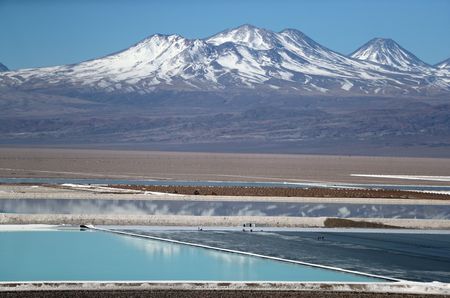By Carman Chew
SINGAPORE (Reuters) – Chilean President Gabriel Boric said on Thursday he would nationalise the country’s lithium industry and create a state-owned company to produce the metal that is a key component of electric vehicle batteries.
Boric said future lithium contracts would only be issued as public-private partnerships with state control. Chile holds the world’s largest lithium reserves and is the world’s second-largest producer.
Following are key details on the global lithium industry. PRODUCTION
Lithium is currently produced from hard rock or brine mines.
Australia is the world’s biggest supplier, with production from hard rock mines. Argentina, Chile and China mainly produce it from salt lakes.
World output was 737,000 tonnes of Lithium Carbonate Equivalent (LCE) in 2022 and is estimated to reach 964,000 tonnes in 2023 and 1,167,000 tonnes in 2024, according to the Resources and Energy Quarterly Report by the Australian Department of Industry, Science and Resources in March.
Rapid growth is forecast to be met by output gains in Australia, Chile and Argentina.
WORLD’S BIGGEST MINES
Greenbushes, Western Australia, by Talison Lithium (a joint venture of Tianqi Lithium, IGO and Albemarle Corp). Current production capacity at 1.34 million tonnes a year of chemical-grade and technical-grade lithium concentrate.
Pilgangoora, Western Australia, owned by Pilbara Minerals, produces 360,000 to 380,000 tonnes of spodumene concentrate per annum, with two expansions underway that will increase production capacity to one million tonnes per annum.
Mt Cattlin, Western Australia, owned by Allkem, the company formed from the merger of Orocobre and Galaxy Resources, produced 194,000 tonnes of spodumene concentrate in 2022.
Mibra, Minas Gerais, Brazil, owned by Advanced Metallurgical Group, produces 90,000 tonnes of spodumene a year, with plans to expand to 130,000 tonnes by the end of Q2 2023.
Mount Marion, Western Australia, owned by Mineral Resources Ltd, was on track to produce 450,000 to 600,000 tonnes of spodumene as of August 2022, with a targeted expansion to 900,000 tonnes per annum delayed until July 2023.
Salar de Atacama, Antofagasta, Chile, owned by Sociedad Quimica y Minera de Chile (SQM), produces 180,000 tonnes of lithium carbonate a year, and expects that to rise to 210,000 by 2024.
Pozuelos-Pastos Grandes lithium salt lake, Argentina, bought by Ganfeng Lithium, will produce 30,000 tonnes of lithium carbonate starting 2024, and can potentially be expanded to 50,000 tonnes.
(Reporting by Carman Chew; Editing by Tony Munroe, Elaine Hardcastle)








